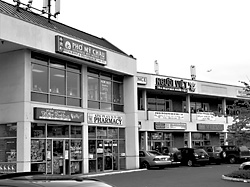The effort to “improve” poor parts of town is always a damned-if-you-do, damned-if-you-don’t proposition. When government leaves a neighborhood to languish, it’s accused of neglect. When it tries to spruce things up, it gets ripped for promoting gentrification.
The double-edged dynamic has been playing out in the Rainier Valley for years now, ever since Sound Transit came up with its plan to run light-rail trains down the center of Martin Luther King Way. A dingy thoroughfare more welcoming to tractor-trailers than people, MLK has since been beautified with new trees, sidewalks, and streetlights. Once the light-rail line is running next year, MLK riders will have the easiest access—there will be multiple stops and you’ll be able to access them at street level, without descending a mile underground as you’ll need to do on Cap Hill.
But many in the Valley, especially business owners along MLK, opposed this plan as racist. They correctly observed that if the Valley were white and affluent, the government could never have gotten away with massively redeveloping a miles-long boulevard, condemning dozens of properties and disrupting travel for years. Up north, of course, Sound Transit tracks are being laid down in tunnels, leaving the surface less disturbed.
Tearing up the street wasn’t the only issue. Opponents and supporters alike saw light rail along MLK as sweetening the pot for developers, especially as new zoning invited clusters of transit-hugging “urban villages.” Light rail was a deliberate government strategy of urban renewal, intended to draw private investment to unpalatable neighborhoods where subsidized housing has long dominated. And it seems to be working: A recent Seattle Times story toted up “more than 1,500 condo and apartment units” currently proposed by private, for-profit developers within a 10-minute walk of an MLK rail station.
Of course, everyone from public officials to the developers themselves insists that maintaining the Valley’s “diversity” is a top priority. According to the Times, developers have said they might even be persuaded to forgo the wealthiest common denominator and offer “workforce” housing (which basically means middle-class)—provided the city offers up some nice tax breaks.
But to visit the intersection of MLK and Othello Street, where a bright light-rail station sits finished and empty, is to see a commercial district both thriving and utterly doomed. This motley collection of herb shops, video stores, markets, and bakeries serves a mostly Southeast Asian clientele in retail environments that make no concession to English-speaking outsiders.
Mind you, a certain amount of piquant diversity can be a valuable selling point for the developers’ target customer. As any reader of StuffWhitePeopleLike is aware, the presence of ethnic shops where you can try out your Spanish, and a general feeling of being a neighborhood “trailblazer,” all carry high appeal among educated strivers. But at MLK and Othello you can almost hear the coming rumble from hundreds of new residents at Othello North and Othello South—twin developments planned alongside the rail line—as they engulf and displace these shops with their buying power and taste for Odwalla Bars. How could they not?
Valiantly struggling against this outcome is the Rainier Valley Community Development Fund. It was set up a decade ago by local pols and Sound Transit board members who were feeling a bit abashed at how this ‘hood was to be reamed by a massive public-works project. The city agreed to put up about $50 million to help offset the effects of construction on the hundreds of small businesses that line MLK, and generally preserve the neighborhood’s character.
Construction has mostly come to an end now (after taking twice as long as planned), and the Fund has paid out about $17 million to cover losses suffered while MLK was an unnavigable war zone. But the real test is ahead, says Martina Guilfoil, who recently became executive director of the Fund. The trains won’t be running until next summer, under the most optimistic projections. Meanwhile, “car traffic left and hasn’t come back yet,” she says. And in a worst-of-all-worlds scenario, everyone’s rents are climbing, she says, because of the “intense speculation and private investment” all along the light-rail line. At the Western Donut near Graham Street, for example, rent has tripled to $3,500 a month, Guilfoil says.
The Development Fund has another $26 million at its disposal to help out businesses and other Rainier Valley groups with loans. And Guilfoil says her staff will be going door-to-door along MLK, offering advice to business owners on “how to enjoy the prosperity” and “expand their goods and services to serve a broader clientele.” But to really have a shot at preserving the texture of the street, the Fund would need to be able to buy land outright, she says. That way it could keep rents at a reasonable level. However, being a landlord isn’t in the Fund’s current job description, and Guilfoil would need approval from the city council, where rent suppression is likely to be none too popular with developer lobbyists.
So unless the city steps in with some kind of regulatory limits, it all seems like a pretty hopeless task. Only the friction of a slowing economy can oppose the forces of gentrification. To be kind is to be cruel when it comes to urban improvements, and it’s hard not to believe that the Rainier Valley Community Development Fund will be remembered for only briefly staving off the inevitable.








